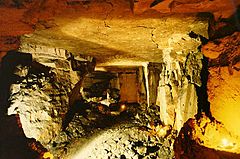Brown's Folly facts for kids
| Site of Special Scientific Interest | |
 |
|
| Area of Search | Avon |
|---|---|
| Coordinates | 51°23′40″N 2°17′56″W / 51.39445°N 2.29891°W |
| Interest | Geological and Biological |
| Area | 98.5 acres (0.399 km2; 0.1539 sq mi) |
| Notification | 1974 |
Browne's Folly is a cool old tower. It sits in a very special nature area. This area is called a Site of Special Scientific Interest (SSSI). It covers about 39.9 hectares. This means it's important for both its rocks and its living things.
The SSSI is near Bathford in Somerset, England. It was made a special site in 1974. The whole area is known as Farleigh Down Stone Quarry. The Avon Wildlife Trust helps to look after it. The tower itself was built in 1848. It is a Grade II listed building, which means it's an important historical building.
This special place is on a steep hillside. It looks over the River Avon. The ground here is made of special rocks. These include clays, fuller's earth, and limestone. These rocks are from the Jurassic period. The rocks here are very important for scientists. They help us understand the Earth's history.
Browne's Folly: A Special Place
The site has old quarries. These quarries were once used to dig up Bath Stone. This stone was used to build many famous places. For example, it helped build Buckingham Palace. These old quarries now offer many homes for wildlife.
Amazing Wildlife
The old piles of stone from the quarry are now covered in plants. You can find wild thyme and harebell here. There are also nine types of orchid. One of these is the rare Fly Orchid. You might also spot a plant called Yellow Bird's-nest.
The wet rock faces are home to many ferns. You can also find different fungi and spiders here. The lower parts of the hill have old woodlands. These woods are home to woodpeckers. They also have unusual plants like Bath asparagus.
Hidden Caves and Bats
The old underground quarries are very interesting. They have cool cave features. You can see delicate stalactites inside. These are rock formations that hang from the cave ceiling.
These disused underground quarries are also a home for bats. The Greater Horseshoe Bat uses them for roosting. Five other types of bats also live here. There is a special area for the main bat roost. Everyone is asked to stay away from this spot. This helps protect the bats.
A famous bat named Boris lived here. He was a Greater Horseshoe Bat. Boris was found at Browne's Folly in January 2000. He was the oldest Greater Horseshoe Bat ever found in Britain! Because of these bats, the SSSI is part of a larger protected area. This area is called the Bath and Bradford-on-Avon Bats Special Area of Conservation.
Access to the Caves
In 2000, access to the underground mines was stopped. This was because of safety rules. These rules protect people who work or volunteer there. For example, people who count bats need to be safe. Before 2000, cavers could visit the mines. They worked with bat groups to protect the bats. They avoided the caves during the bat roosting season.

